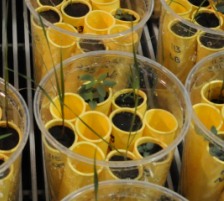Invasion and restoration of sand prairies
 Positive
feedback mechanisms may promote the continued dominance of
some invasive plants, making restoration difficult. My students'
work has examined the response of sand prairie communities and
species to restoration treatments aimed at controlling smooth
brome (Bromus inermis) and thus promoting native plant
establishment. Sand prairies are a threatened plant community type
in Wisconsin, home to many species of conservation interest.
Positive
feedback mechanisms may promote the continued dominance of
some invasive plants, making restoration difficult. My students'
work has examined the response of sand prairie communities and
species to restoration treatments aimed at controlling smooth
brome (Bromus inermis) and thus promoting native plant
establishment. Sand prairies are a threatened plant community type
in Wisconsin, home to many species of conservation interest.
To date, we have found no evidence that positive feedbacks inhibit prairie plant growth after smooth brome control. We have identified treatments that effectively decrease smooth brome cover and promote prairie restoration. Furthermore, native plants grew better in soil collected from a smooth brome monoculture than in soil from an agricultural field. Thus, brome fields may be prime sites for prairie restorations.
I am seeking a M.S. student interested in re-surveying our existing plots to evaluate longer-term
restoration outcomes. This
work is being carried out in collaboration with my students, my
UW-L colleague Tom Volk, and the Mississippi Valley Conservancy;
s

